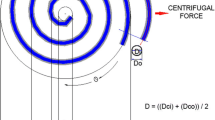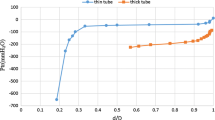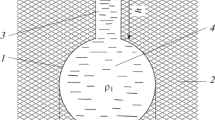Abstract
Oxygen transfer to blood and water was investigated experimentally for steady flow in a ‘complex coil’, a silicone-rubber tube formed into a sequence of helical coil sections of alternating orientation. The series of reorientations caused the secondary flow induced by the helical motion to be continually re-established, so that mixing of the liquid was enhanced. Complex coils of various configurations were tested in an oxygen atmosphere and a significant improvement of the oxygen-transfer to the liquids was measured while the pressure drop increased moderately. The case of ideal oxygen transfer, i.e. a perfectly mixed fluid, was treated theoretically and a comparison of these results with the experimental data demonstrated how much the fluid-side resistance was reduced by complex coiling.
Sommaire
Le passage de l’oxygène dans le sang et dans l’eau fut étudié de façon expérimentale pour un débit constant dans une ‘spirale complexe’, tube en caoutchouc de silicone constitué d’une série de sections hélicoìdales à orientation alternée. La série de réorientations provoquait le rétablissement continu du flux secondaire induit par le mouvement hélicoìdal, de manière à accroître le mélange du liquide. Des spirales complexes de diverses configurations furent soumises à des essais dans une atmosphère d’oxygène et une amélioration significative du passage de l’oxygène dans les liquides fut mesurée alors que la chute de pression s’intensifiait modérément. Le cas d’un transfert idéal d’oxygène—par example dans un liquide parfaitement mélangé—fut traité de façon théorique et une comparaison de ces résultats avec les données expérimentales a demontré à quel point la résistance latérale du liquide était réduite par le système de spirales complexes.
Zusammenfassung
Sauerstoffübertragung an Blut und Wasser wurde experimentell für stetige Strömung in einer ‘komplexen Spule’ untersucht, einem Silikonkautschukrohr, das in eine Folge von Wendelspulen alternativer Orientierung geformt wurde. Die Reihe von Wieder-Orientierungen verursachte die fortgesetzte Wiederherstellung des von der Spiralbewegung induzierten Sekundärstromes, so daß die Mischung der Flüssigkeit gefördert wurde. Komplexe Spulen verschiedener Konfiguration wurden in einer Sauerstoffatmophäre geprüft und es wurde eine beträchtliche Verbesserung der Sauerstoffübertragung an die Flüssigkeiten gemessen, während der Druckanfall ein wenig anstieg. Der Fall der idealen Sauerstoffübertragung-d.h. an eine vollkommen gemischte Flüssigkeit- wurde theoretisch behandelt und ein Vergleich dieser Resultate mit den experimentellen Daten zeigte, um wieviel der Widerstand von Seiten der Flüssigkeit durch komplexe Spulung verringert wurde.
Similar content being viewed by others
Abbreviations
- a :
-
internal tube radius, cm
- a 1,a 2,a 3 :
-
coefficients of the modified Hill equation (eqn. 5)
- c :
-
concentration, mole/cm3
- c s :
-
amount of oxygen per unit blood volume bound to haemoglobin at full saturation (s=1), cm3 (s.t.p.)/100 ml blood or mole/cm3
- d :
-
internal tube diameter, cm
- d h :
-
hydraulic diameter = (4-times area)/circumference), cm
- D :
-
coil diameter, cm
- De :
-
Re√(d/D), Dean number
- D m :
-
oxygen diffusivity in the membrane, cm2/s
- f :
-
Δp(d/L)/(v 2 g/2), friction factor
- f s :
-
64/Re, friction factor for laminar flow in straight tubes
- G :
-
4(αD) m /(αD) wb , dimensionless membrane permeability
- Hb :
-
total haemoglobin concentration of the blood = (g haemoglobin)/(100 ml blood),g%
- L :
-
tube length, cm
- P :
-
(p−p 0)/(p g −p 0), dimensionless partial pressure of oxygen
- P f :
-
dimensionless partial pressureP in the ideally mixed fluid
- p :
-
partial pressure (of oxygen), mmHg
- p co 2 :
-
partial pressure of carbon dioxide mmHg
- p o2 :
-
partial pressure of oxygen, mmHg
- p g :
-
gas-side partial pressure of oxygen, mmHg
- p o :
-
inlet oxygen partial pressure of the fluid, mmHg
- p 1 :
-
outlet oxygen partial pressure of the fluid, mmHg
- Δp :
-
static pressure drop along the tube axis, mmHg
- pH:
-
standard measure for the concentration of free hydrogen ions
- Q :
-
flow rate, ml/min
- R :
-
r/a, dimensionless radial co-ordinate
- r :
-
radial co-ordinate, cm
- Re :
-
vd/v=2a v/v, Reynolds number
- s :
-
degree of oxygen saturation of blood haemoglobin (0≤s≤1)
- Sc :
-
(v/D o2) wb , Schmidt number for oxygen diffusion in whole blood (=wb)
- T :
-
temperature, deg C
- v :
-
mean velocity, cm/s
- W :
-
w/a, dimensionless wall thickness
- w :
-
wall thickness, cm
- Z :
-
(z/a) G/(Re Sc), dimensionless axial co-ordinate
- z :
-
axial co-ordinate, cm
- (αD) m :
-
membrane oxygen-permeability, mole/(s cm mmHg)
- α f :
-
effective oxygen-solubility of the fluid, for blood, α f is defined by eqn. 4, mole/(cm3 mmHg)
- α f *:
-
α f /α wb , dimensionless effective oxygen solubility for whole blood
- α m :
-
membrane oxygen solubility, mole/(cm3 mmHg)
- α wb :
-
oxygen solubility of the whole blood, including plasma and red cells, mole/(cm3 mmHg)
- ν:
-
kinematic viscosity, cm2/s
References
Altman, D. L. (1971)Respiration and circulation. Biological Handbook, Federation of American Societies for Experimental Biology
Baurmeister, U. (1974) Oxygen transport to blood flowing in coiled semipermeable tubes. M.Sc. thesis, Univ. of Toronto
Bischoff, K. B. andT. M. Regan (1971) Comments on diffusion in membrane-limited blood oxygenators.Amer. Inst. Chem. Eng. J. 17, 225
Blackshear, P. L. Jun. (1972) Mechanical haemolysis in flowing blood. In:Biomechanics, its foundations and objectives. Eds.Y. C. Fung, N. Perrone andM. Anliker, 501. Prentice Hall, New Jersey
Buckles, R. G., E. W. Merrill andE. R. Gilliland (1967) An analysis of oxygen absorption in a tubular membrane oxygenator.Amer. Inst. Chem. Eng. J. 14, 703
Dean, W. R. (1928) The streamline flow of fluid in a curved pipe.Phil. Mag. 4, 673
Dorson, W. J. Jun.,Larsen, K. G., Elgas, R. J. andVoorhees, M. E. (1971) Oxygen transfer to blood data and theory.Trans. Am. Soc. Artif. Intern. Organs 17, 309
Dravid, A. N., Smith, K. A., Merrill, E. W. andBrian, P. L. T. (1971) Effect of secondary fluid motion on laminar flow heat transfer in helically-coiled tubes.Amer. Inst. Chem. Eng. J. 17, 1114
Drinker, P. A. (1972) Progress in membrane oxygenator design.Anaesthesiology 37, 242
Kalb, C. E. andSaeder, I. D. (1974) Fully developed viscous-flow heat transfer in circular tubes with uniform wall temperature.Amer. Inst. Chem. Eng. J. 20, 340
Lee, W. H., Krummhaar, D., Derry, G., Sachs, D., Lawrence, S. H., Clowes, G. H. A. andMaloney, J. V. (1961) Comparison of the effects of membrane and non-membrane oxygenators on the biochemical and biophysical characteristics of blood.Surg. Forum 12, 200
Madras, P. A., Morton, W. A. andPetscheck, H. E. (1971) Dynamics of thrombus formation.Fed. Proc. 30, 1665
Mockros, L. F. andWeissman, M. H. (1971) The artificial lung. In:Biomedical engineering. Eds.L. H. U. Brown, J. E. Jacobs andL. Stark, 325. F. A. Davis Co., Philadelphia
Peirce, E. C. II (1972) The role of the artificial lung in the treatment of respiratory insufficiency: A perspective.Chest 62, 107 S
Richardson, P. D. (1971) Effects of secondary flow in augmenting gas transfer in blood. In:Advances in cardiology vol. 6. Eds.R. H. Bartlett, P. A. Drinker andP. M. Galetti, 2, S. Karger, Basel
Rossing, R. G. andCain, S. M. (1966) Dog oxyhaemoglobin dissociation curve.J. Appl. Physiol. 21, 198
Weissman, M. H. (1969) Diffusion in membrane-limited blood oxygenators.Amer. Inst. Chem. Eng. J. 15, 627
Weissman, M. H. andMockros, L. F. (1969) Oxygen and carbon dioxide transfer in membrane oxygenators.Med. & Biol. Eng. 7, 169
White, C. M. (1929) Streamline flow through curved pipes.Proc. Roy. Soc. 123A, 645
Author information
Authors and Affiliations
Rights and permissions
About this article
Cite this article
Baurmeister, U., James, D.F. & Zingg, W. Blood oxygenation in coiled silicone-rubber tubes of complex geometry. Med. Biol. Eng. Comput. 15, 106–117 (1977). https://doi.org/10.1007/BF02442953
Received:
Accepted:
Issue Date:
DOI: https://doi.org/10.1007/BF02442953




